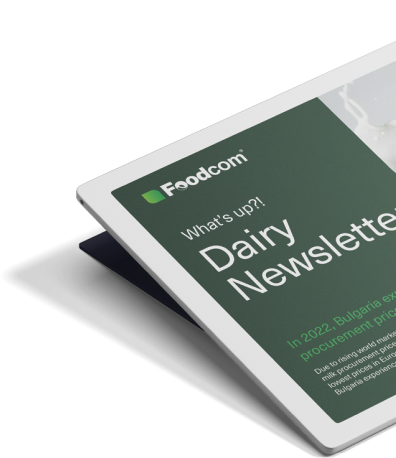- The tariffs introduced by the Trump administration destabilise the dairy trade between the USA and the EU, particularly affecting Irish butter exports.
- The US dairy industry undergoes a genetic revolution, significantly increasing the fat and protein content of milk.
- Global prices for dairy products, especially butter and cream, are reaching record highs despite regional differences in supply and demand.
- The export and production of milk powder and cheese in the USA and the EU are under pressure from weak demand, growing inventories and fluctuating exchange rates.
Welcome Partners!
Welcome back to our newsletter!
Global dairy markets remain under pressure, with butter prices reaching record levels in many regions and cream values firming at the end of last week. US cheese markets continue to fall in the face of rising milk production, while demand for milk powder remains weak despite lower production. Regional price differences are emerging in Europe, especially for cream and SMC. Meanwhile, political and labour tensions in the US and strong genetic gains in milk ingredients are changing the outlook for the US dairy sector. What you don’t know today could cost you tomorrow.
Let’s take a look at what’s been happening in the dairy market lately!
Milk powder
Food-grade skimmed milk powder (SMP) prices in Europe have increased, with current spot offers ranging from 2350 – 2400 EUR/MT, depending on the age and origin of the product. Last week, prices in the Baltic region fluctuated around 2300 EUR/MT, but are now heading towards 2350 EUR/MT, in line with broader market movements. Export activity remains limited despite slightly more attractive prices, but demand remains uneven due to global uncertainty and exchange rate fluctuations.
Wholesale prices for feed grade SMP are also rising, with spot values around 2400 EUR/MT. Q2 contracts have closed at similar levels. DAP NL deliveries remain stable, confirming steady demand. Expectations of increased milk consumption in the coming weeks may moderate the trend, but current support remains high.
In the US, skimmed milk powder production remains low despite increasing milk availability, with January production at its lowest since 2016. Slow export activity has led to an increase in stocks, reflecting cautious buying behaviour.
Whole milk powder in the EU has fallen slightly in line with butter. Current price levels in the EU are around 4300-4350 EUR/MT, while WMP from Oceania is offered at around 3700 EUR/MT. Due to weak demand in Europe, most producers are prioritising other dairy lines. The gap between EU and NZ WMP remains, albeit narrowing. No major price fluctuations are expected in the short term.
Cheese
After peaking in early March, gouda has hit some price resistance, with buyers hesitant to commit above 4450 EUR/MT. Spot transactions fell slightly to 4300-4350 EUR/MT. Some transactions were even reported below 4300 EUR/MT, indicating selective buying. In Central Europe, however, prices have held firmer, with current levels closer to 4400-4450 EUR/MT and showing signs of stability.
Edam 40% is moving in parallel to Gouda, with current spot levels settling around 4300-4350 EUR/MT. Although stock levels are still manageable, buyer indecision is increasing in the face of potential peaks.
Prices for mozzarella blocks have also softened slightly, with current transactions recorded at 4300-4350 EUR/MT. While demand remains relatively stable, producers are facing increasing competition and early signs of buyer opposition.
Spot prices for emmental cheese remain stable, supported by limited production and strong demand.
Cheddar remained stable for most of March, but is now showing the first signs of weakness. Spot prices have fallen slightly to 4700-4800 EUR/MT, with weakening demand from EU buyers. Export opportunities remain, but competition from AU/NZ and the US is increasing.
US cheddar prices fell significantly in March, with spot block and barrel prices reaching 11-month lows amid rising production and weak domestic demand.
Fats
Butter continues to dominate the conversation. Despite some price declines, spot levels remain high at 7200-7300 EUR/MT. Lower cream prices have allowed for more production, but buyers have acted quickly, grabbing volumes. Butter of Ukrainian origin is being offered much lower, at around 6800-6900 EUR/MT, with delivery across Europe. Retail prices remain wide, with market estimates suggesting they will reach 7300-7600 EUR/MT in April. As milk consumption is expected to increase and US-origin butter gains ground in the European market, additional softening may occur. Nevertheless, strong domestic demand and a limited number of fresh offers continue to provide price support and keep the market active.
Anhydrous milk fat continues to follow the general fat complex, but with limited recent movements. Production is limited in both Europe and the US, supporting current levels above 9000 EUR/MT.
Despite the large volume of cream and strong butter production in the US, stocks grew at a typical pace, suggesting good domestic utilisation and export interest due to prices.
Liquids
Cream prices remain high across the continent. Last week, prices fluctuated between 8500-8600 EUR/MT, but strong interest and a wave of enquiries towards the end of the week pushed values slightly higher, reinforcing the tone of the market. We will now keep a close eye on market behaviour in the coming days. This translates into a theoretical butter return of 7250-7300 EUR/MT. With Easter approaching in just three weeks, further volatility is possible.
In the US, cream is currently plentiful and inexpensive, which is driving high utilisation rates in butter plants.
SMC prices remain stable, with the German-origin product in the 1975-2000 EUR/MT FCA DE range. As the availability of milk and powder production increases, demand for SMC decreases slightly. In comparison, SMC prices in France and the Netherlands are quoted at a slight premium, reflecting regional differences in availability and product flow.
Spot prices for raw milk in the main EU countries continue to fall, reflecting improved milk flows. Current levels average around 0.50-0.53 EUR/kg, depending on region and fat/protein content. However, concerns over the bluetongue outbreak in Slovakia and Hungary remain on the radar.
Whey powder
Sweet whey powder (SWP) remains unchanged, quoted at 1100 EUR/MT across Europe. Limited buying interest remains as many expect further downward pressure on milk prices.
Feed whey powder is stable at 900 EUR/MT. However, DAP NL supplies in Q2/Q3 have seen some softening, with quotes down around 910-920 EUR/MT. Sweet whey concentrate markets are very volatile, fluctuating between 400-600 EUR/MT FCA in one day earlier this week.
European WPC80 instant prices remain high at 11800-12000 EUR/MT, with Polish suppliers occasionally offering as much as 11400-11500 EUR/MT. Global demand remains solid, with a steady flow towards China, India and South America. Most volumes for Q2 are already contracted. With limited availability and no significant increase in supply expected, prices are likely to remain stable in Q2.
WPI prices in Europe are at 22500 EUR/MT, with limited availability and only minor price movements from domestic producers. WPI sourced from the US is coming to market, but has not triggered significant price action due to potential tariff risk. Supply remains limited. Prices may fluctuate unpredictably, but significant declines seem unlikely under current conditions.
Whey prices in the US declined slightly in March as buyers refrained from breaching key price levels, anticipating a future increase in supply associated with rising cheese production.
What’s new?
North America
President Donald Trump’s trade policies, including the introduction of tariffs on dairy products and plans for mass deportations of immigrants, are presenting the US dairy industry with serious challenges. New tariffs imposed on imports from Canada and Mexico are designed to protect domestic producers, but experts warn that they could lead to higher domestic dairy prices.
In addition, the deportations of illegal immigrants announced by the Trump administration are causing concern among dairy farmers, who rely heavily on migrant labour. The loss of experienced workers could disrupt farm operations and reduce productivity. In the face of these actions, US farmers and consumers alike could be negatively affected by changes to US trade and immigration policies.
Global
President Donald Trump’s administration’s planned 25 per cent tariffs on agri-food products from the European Union could significantly impact Irish butter exports to the US. Last year, Ireland exported around 60,000 tonnes of butter to the US market, a significant segment of the dairy industry there. Experts warn that the introduction of tariffs could make butter prices unaffordable for consumers, leading to a fall in demand and the need for producers to reduce prices.
Christophe Lafougere, CEO of GIRA, highlights that the Irish dairy industry is heavily reliant on the US market as a key market outside of Europe. In the face of these challenges, the Irish government pledges to continue to protect trade relations with the US, and the Minister of Agriculture is planning a trade mission to the US to highlight investment by Irish food companies in the market there.
North America
US dairy producers are increasingly using advanced genetic techniques to increase the fat and protein content of milk, which is key to the production of cheese, butter and other popular dairy products. Although total milk production in the US remains stable, there is record growth in these important ingredients, driven by the selection of animals for desirable genetic traits.
The use of genomics allows breeders to precisely select animals for breeding, resulting in significant increases in the fat and protein content of milk. Over the past 15 years, fat production has increased by 30.2% and protein by 23.6%, while overall milk production has increased by 15.9%. These changes not only benefit producers financially, but also support the growth of the processing industry, which plans to introduce $8 billion worth of new capacity by 2027.
![Price records, new technologies and geopolitics – global challenges for the dairy industry [262nd Edition of DAIRY Newsletter] Price records, new technologies and geopolitics – global challenges for the dairy industry [262nd Edition of DAIRY Newsletter]](https://foodcom.pl/wp-content/uploads/2023/08/Foodcom_SA_Whats_up_Dairy_Newsletter-1520x760.jpg)






